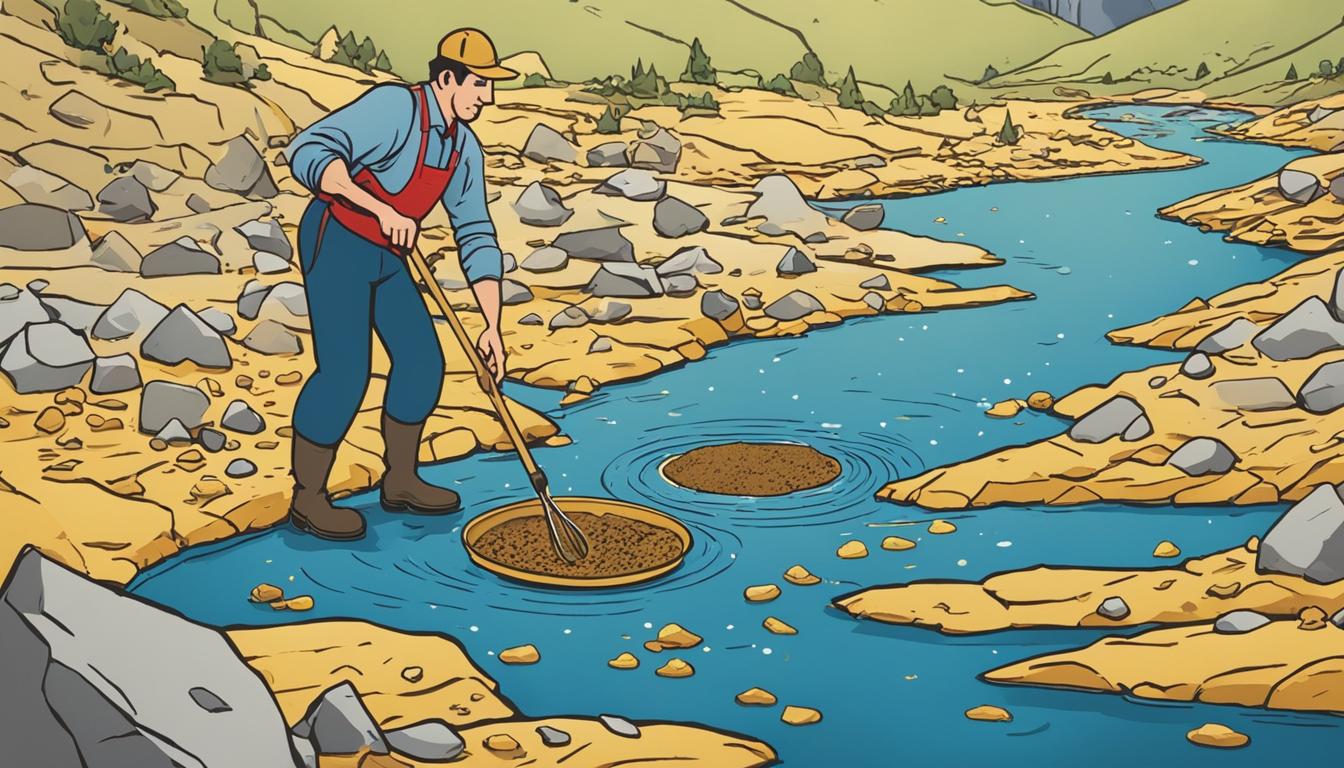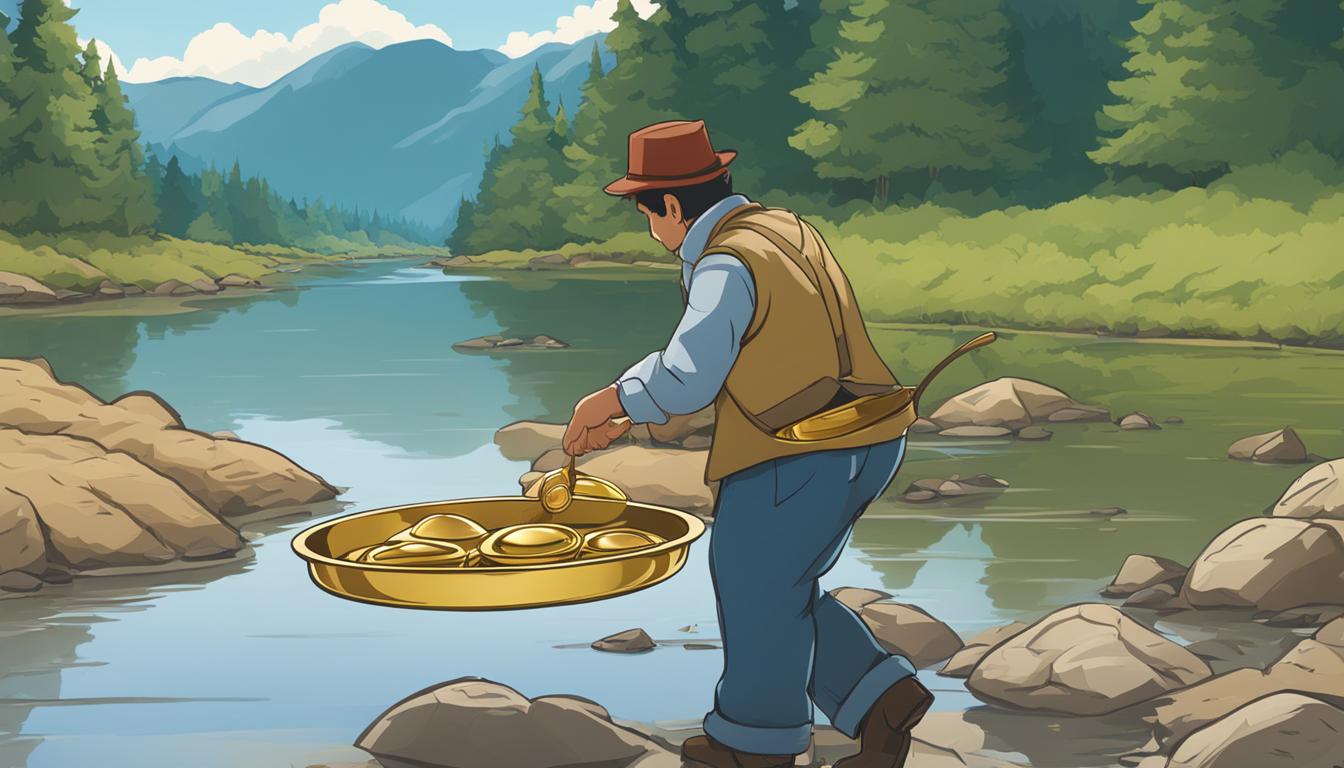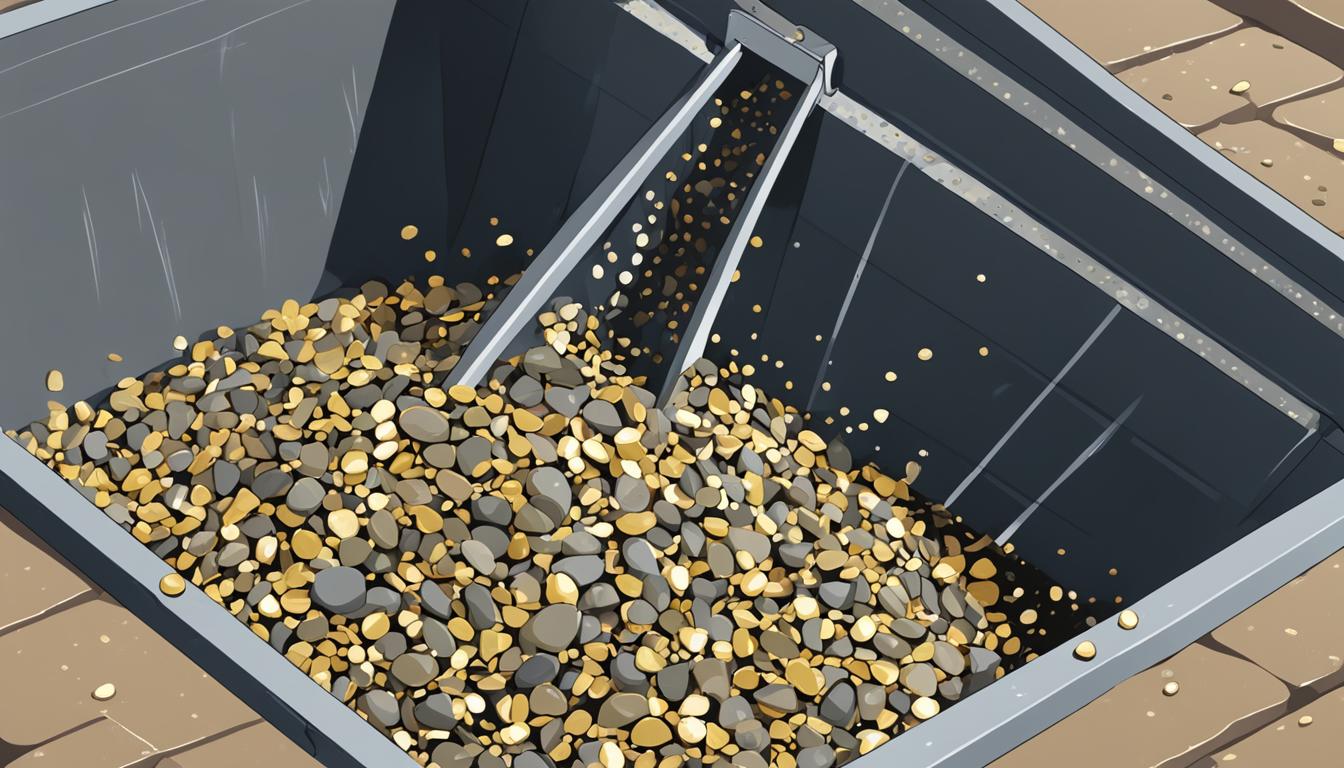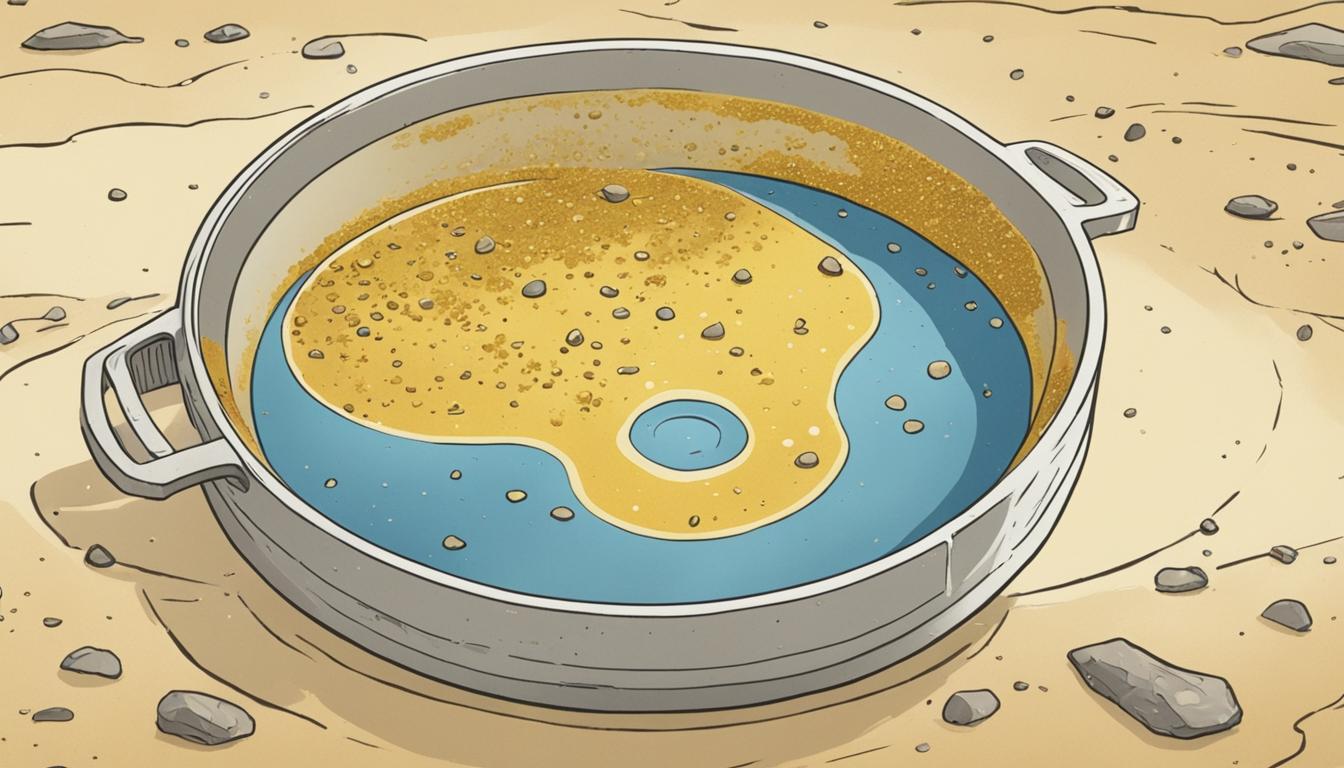
As a beginner prospector, understanding how weather changes can impact your prospecting journey is essential for success. Weather adaptation plays a crucial role in determining when and where to prospect, as well as which techniques and gear to use. By adapting to weather changes, you can maximize your chances of finding gold and have a more rewarding experience overall.
Prospecting seasons vary depending on the location, influenced by factors such as water levels and temperature. By adapting to these seasonal changes, you can take advantage of the unique opportunities presented by each time of year. Whether it’s winter, spring, summer, or fall, there are specific tips and techniques that can help you navigate the weather and improve your prospecting outcomes.
Key Takeaways:
- Understanding seasonal changes is crucial for successful prospecting.
- Adapting techniques and gear based on weather conditions increases your chances of finding gold.
- Each season offers unique advantages and challenges for prospectors.
- Networking with experienced prospectors and joining local clubs can provide valuable tips.
- Embracing weather changes can lead to exciting discoveries and enjoyable prospecting experiences.
Winter Gold Prospecting Tips
Winter is an ideal season for gold prospecting, offering unique opportunities due to lower water levels and reduced competition. To make the most of your winter prospecting adventures, it’s important to be prepared and stay safe in the cold weather.
Dressing appropriately is crucial for staying warm and comfortable during winter gold prospecting. Layered clothing is key, allowing you to adjust your insulation as needed. Start with a moisture-wicking base layer, add a warm mid-layer, and top it off with a waterproof and windproof outer layer to protect against the elements.
Insulated waterproof boots are essential for keeping your feet warm and dry in winter weather. Look for boots with a sturdy rubber sole and insulation rated for subzero temperatures. Remember to wear moisture-wicking socks to keep your feet dry and prevent frostbite.
When prospecting during the winter, it’s important to stay hydrated despite the lower temperatures. Even though you may not feel as thirsty as you would in hot weather, drinking water regularly helps maintain your body’s fluid balance and prevent dehydration. Carry a water bottle or hydration pack with you and take sips at regular intervals.
Caution should be taken when dealing with ice during winter gold prospecting. Walking on frozen bodies of water can be hazardous, as ice thickness can vary and may not always be strong enough to support your weight. Before venturing out onto ice, make sure it is at least 4 inches thick and check for any warning signs or local regulations.
Using the right tools can greatly enhance your efficiency and success in winter prospecting. A gold pan with deeper sidewalls allows for easier handling of material, preventing valuable gold from escaping. Additionally, using a scoop with an extended handle helps reach deeper and collect material even when wearing gloves.
| Winter Gold Prospecting Tips |
|---|
| 1. Dress in layered clothing for warmth and adjust insulation as needed. |
| 2. Wear insulated waterproof boots and moisture-wicking socks. |
| 3. Stay hydrated despite the lower temperatures. |
| 4. Exercise caution when dealing with ice and check for ice thickness before walking on frozen bodies of water. |
| 5. Use a gold pan with deeper sidewalls and a scoop with an extended handle. |
Stay Warm and Find Gold in Winter
With these winter gold prospecting tips, you can make the most of the season and increase your chances of finding valuable gold. Stay warm, dress appropriately, stay hydrated, and use the right tools for efficient prospecting. Enjoy the beauty of prospecting in winter weather while uncovering hidden treasures.
Spring Gold Prospecting Tips
As winter melts away and spring emerges, it’s an exciting time for gold prospectors. Spring brings with it melting snow and increased water flow, uncovering new gold deposits that were hidden during the colder months. To make the most of your spring gold prospecting adventures, here are some valuable tips:
Research and Reassess Potential Areas
Before heading out, take the time to research and reassess potential prospecting areas. The changing water levels and increased flow can expose new gold-bearing areas that were previously inaccessible. By consulting geological maps, historical records, and local prospecting guides, you can identify promising locations and increase your chances of success.
Focus on Moving Water
During spring, rivers and streams experience a surge in flow, and gold particles tend to settle in areas where water is moving. Focus your prospecting efforts on these areas as they have a higher likelihood of containing gold deposits. By carefully panning and sluicing near the currents, you can effectively capture gold particles in fast-flowing water and improve your yield.
Utilize Specialized Equipment
To optimize your spring prospecting, make sure you have the right tools at your disposal. Consider using a gold pan with larger riffles to capture fine gold particles that might be present in the fast-flowing water. Additionally, a sluice box is highly effective in processing larger amounts of material and trapping fine gold. Utilizing these specialized tools will enhance your chances of finding significant amounts of gold during the spring season.
| Spring Gold Prospecting Tips |
|---|
| Research and reassess potential areas |
| Focus on moving water |
| Utilize specialized equipment |
Embrace the vibrant and rewarding season of spring by implementing these gold prospecting techniques. Remember to conduct thorough research, focus on areas with moving water, and use specialized equipment for maximum efficiency. By following these tips, you’ll increase your chances of uncovering that glittering springtime gold.
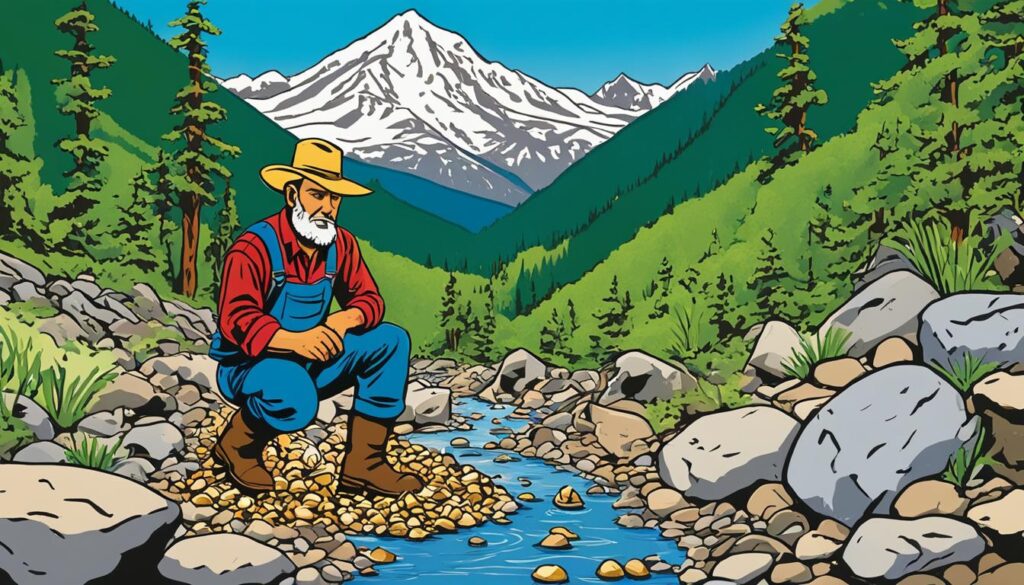
Stay tuned for the next section, where we’ll explore summer gold prospecting tips and techniques.
Summer Gold Prospecting Tips
Summer is a fantastic time for gold prospecting as it allows access to previously inaccessible areas. However, it’s crucial to take precautions for the challenges of heat and water scarcity. By following these summer gold prospecting tips, you can make the most of your prospecting adventures.
- Incredible image of summer gold prospecting:
Dry Washing Technique
During the summer, when water sources may be limited, the dry washing technique becomes especially useful. Dry washing involves using a dry washer, a specialized piece of equipment that separates gold from dry materials like gravel and sand without the need for water.
Metal Detecting
Metal detecting is another effective technique for summer gold prospecting. With the ground being drier and less muddy, metal detectors can easily detect gold nuggets and other valuable targets. Metal detecting allows you to cover larger areas quickly and can be particularly rewarding in previously worked areas.
“Summer is the perfect time to explore new prospecting techniques and techniques for summer prospecting.”
While engaging in summer gold prospecting, it’s essential to prioritize your safety and well-being:
- Wear appropriate sun protection such as a wide-brimmed hat, sunglasses, and sunscreen.
- Stay hydrated by carrying enough water and drinking regularly.
- Wear proper clothing to protect yourself from the sun, including long sleeves and lightweight, breathable fabrics.
- Cover your feet with sturdy, closed-toe shoes to protect them from uneven terrain and potential hazards.
- Carry essential supplies such as a first aid kit, insect repellent, and a portable phone charger.
Stay safe and enjoy your summer gold prospecting adventures!
Fall Gold Prospecting Tips
Fall is an exciting season for gold prospecting, offering unique opportunities for enthusiasts to discover valuable treasures. As the weather cools down and nature transitions, prospectors can take advantage of certain conditions and techniques to increase their chances of success.
Finding Gold After Extreme Weather Events
Extreme weather events, such as heavy rain or storms, can impact gold deposits and expose new areas with potential gold-rich material. Pay attention to news reports and local geological surveys to identify regions that have experienced significant weather events. These areas could hide hidden gold deposits that can be uncovered during the fall prospecting season.
Planning Your Prospecting Trip
During fall, drought conditions may limit water availability in certain waterways. To optimize your prospecting efforts, it’s essential to plan your trip to areas known for better water availability during this season. Research and consult local prospecting communities or clubs to gather information on water sources and determine locations with promising gold potential. Being strategic with your travel destinations can greatly increase your chances of finding gold.
Harnessing the Power of Downslope Winds
One unique advantage of fall prospecting is the effect of downslope winds. These winds can scrub away surface material, exposing underlying bedrock and concentrating gold particles. Prospecting areas previously deemed unproductive may become valuable for metal detecting due to the wind’s action. Pay attention to wind patterns and identify locations where downslope winds are prevalent to increase your chances of finding gold.
Understanding Water Table Elevations and Annual Precipitation
Knowledge of water table elevations and annual precipitation patterns can provide valuable insights into the distribution of gold in waterways. Research and analyze data on water levels, as well as local precipitation trends during the fall season. This information can help you identify areas where gold particles are likely to accumulate and increase your chances of successful prospecting.
| Fall Gold Prospecting Tips | Description |
|---|---|
| Finding Gold After Extreme Weather Events | Pay attention to regions that have experienced extreme weather events, as they can expose new areas with potential gold deposits. |
| Planning Your Prospecting Trip | Research and plan your trip to areas with better water availability during the fall season. |
| Harnessing the Power of Downslope Winds | Take advantage of downslope winds, which can scrub away surface material and expose gold-rich areas. |
| Understanding Water Table Elevations and Annual Precipitation | Gain insights into the distribution of gold by researching water table elevations and analyzing local precipitation patterns. |
By implementing these fall gold prospecting techniques, enthusiasts can optimize their efforts and increase their chances of finding valuable gold. Don’t miss out on the unique opportunities that the fall season offers. Get out there, explore, and uncover the hidden treasures that await!

Preparing for Weather Changes in Prospecting
When it comes to gold prospecting, being well-prepared for weather changes is crucial. The right gear and equipment can make all the difference in adapting to different weather conditions. Here are some tips on how to prepare for weather changes in prospecting:
Layered Clothing and Waterproof Gear
One of the key elements in weather adaptation is proper clothing. Layering your clothing allows you to adjust to changing temperatures throughout the day. Start with a moisture-wicking base layer to keep you dry, add a insulating mid-layer for warmth, and finish with a water-resistant or waterproof outer layer to protect you from rain or snow. This layering system ensures that you stay comfortable and prepared for varying weather conditions.
Awareness of Potential Hazards
It’s important to be aware of potential hazards that can arise from weather changes during prospecting. In colder months, be cautious of icy conditions and slippery terrain. Always carry an ice gripper attachment for your boots to improve traction and reduce the risk of falls. During hotter months, be mindful of heat-related illnesses such as heatstroke or dehydration. Stay hydrated, wear sun protection, and take regular breaks in shaded areas to prevent heat-related issues.
Essential Supplies and Equipment
In addition to clothing and safety precautions, it’s essential to carry the right supplies and equipment for weather adaptation in prospecting. Here are some must-have items:
- An all-weather backpack to carry your gear and supplies
- A first aid kit with essentials like bandages, antiseptic, and pain relievers
- A portable shelter or tent for protection against harsh weather conditions
- A reliable GPS device to navigate through unfamiliar terrain
- Extra batteries or power banks for charging electronic devices
When it comes to equipment, choose tools specifically designed for varying weather conditions. Ensure that your gold pan has deeper sidewalls to prevent water overflow in wet conditions. Opt for a scoop with an extended handle to reach difficult-to-access spots. If you’re prospecting in rainy conditions, consider using a waterproof metal detector for better durability and performance.
Remember, investing in the right gear and being prepared for weather changes will greatly enhance your prospecting experience and increase your chances of finding gold.
By following these tips and preparing for weather changes, you’ll be well-equipped to adapt to varying conditions and make the most of your prospecting adventures.
Prospecting Tips for Changing Seasons
Prospecting for gold is a dynamic activity that changes with the seasons. Each season presents its own set of challenges and advantages for prospectors. To maximize your chances of success, it’s important to adapt your techniques, research potential areas, and be flexible in your approach.
One key aspect of adapting to changing seasons is understanding how seasonal changes impact the movement of water and sediment. For example, in the spring, melting snow and increased water flow can uncover new gold deposits. By targeting areas where water is moving, such as rivers and streams, you can increase your chances of finding gold particles that have settled in these locations.
Networking with experienced prospectors can also be invaluable. Connecting with local clubs or joining online communities can provide you with valuable tips and insights specific to each season. Experienced prospectors can share their knowledge of productive areas during different seasons, helping you focus your efforts in the right places.
Remember, the key to successful prospecting in changing seasons lies in adapting your techniques, researching potential areas, and being open to new opportunities.
To visually showcase the effects of seasonal changes on gold prospecting, refer to Table 1 below:
| Season | Impact on Prospecting |
|---|---|
| Winter | Lower water levels and reduced competition |
| Spring | Melting snow uncovers new gold deposits and increased water flow |
| Summer | Access to previously inaccessible areas, but caution needed for heat and water scarcity |
| Fall | Opportunities after extreme weather events. Pay attention to wind patterns for metal detecting. |
Table 1: Impact of Seasons on Gold Prospecting
By adapting your techniques, understanding the effects of seasonal changes, and leveraging the insights of experienced prospectors, you can enhance your prospecting success throughout the year. Stay flexible, stay informed, and embrace the unique challenges and advantages that each season brings!
Benefits of Adapting to Weather Changes in Prospecting
Adapting to weather changes in prospecting brings numerous benefits that can enhance your overall experience and increase the likelihood of finding valuable gold. By understanding how weather affects water flow, sediment movement, and gold distribution, prospectors can gain a competitive edge and improve their chances of success.
Adapting techniques and gear according to specific weather conditions allows for efficient and effective prospecting. Whether it’s winter, spring, summer, or fall, understanding the seasonal changes and adjusting your approach accordingly can lead to significant advancements in finding gold.
One of the advantages of weather adaptation is access to less crowded areas. By prospecting during off-seasons or in unfavorable weather conditions, you can avoid the competition and increase your chances of discovering gold-rich spots that are often overlooked by others.
Furthermore, weather changes can uncover new opportunities for finding gold. For example, melting snow in the spring or extreme weather events can expose previously hidden gold deposits, which can be a game-changer for prospectors who adapt their techniques and seek out these newly exposed areas.
By embracing weather changes in prospecting, you develop a deeper understanding of the natural forces at play. This knowledge empowers you to make informed decisions about where to prospect, maximizing your chances of finding valuable gold. It also allows you to appreciate the intricacies of nature and immerse yourself in the adventure of prospecting.
Adapting Techniques and Gear for Successful Weather Prospecting
To make the most of weather changes in prospecting, it’s crucial to adapt your techniques and gear accordingly. Here are some tips:
- Research and Plan: Stay informed about weather patterns and how they affect gold distribution. Plan your prospecting trips meticulously based on weather forecasts and available resources.
- Adjust Gear: Invest in gear suitable for different weather conditions. For example, during winter prospecting, ensure you have warm, layered clothing, waterproof boots, and tools specifically designed for cold weather.
- Use the Right Tools: Depending on the season, certain tools and equipment may be more effective. For instance, using a gold pan with larger riffles in fast-flowing water during the spring can help you capture gold particles more efficiently.
- Learn from Experienced Prospectors: Connect with experienced prospectors who have mastered weather adaptation. Their insights and advice can prove invaluable in your quest for successful weather prospecting.
Weather Savvy Prospecting for Beginners
When it comes to gold prospecting, being weather-savvy is a key factor in maximizing your chances of success. As a beginner, understanding and adapting to weather changes can make a significant difference in your prospecting journey. By following these beginner-friendly tips for weather changes, you’ll be well-equipped to navigate different seasons and increase your prospecting success.
- Stay Informed with Seasonal Tips: Each season brings its own set of challenges and advantages for prospecting. Research and familiarize yourself with the specific tips and techniques relevant to the season you’re prospecting in. Whether it’s winter, spring, summer, or fall, understanding the effects of weather changes on gold deposition and movement can guide you towards productive areas.
- Prepare and Adapt Gear: Varying weather conditions require appropriate gear preparation. Invest in layered clothing to adapt to temperature fluctuations and ensure comfort during your prospecting trips. Waterproof boots will keep your feet dry and insulated. Don’t forget to protect yourself from the sun with hats and sunscreen in summer, and be prepared for cold temperatures in winter with thermal gear.
- Take Advantage of Off-Season Prospecting: Off-season prospecting can offer unique advantages, such as less crowded areas and increased access to spots with good gold potential. Use this time to explore areas that are usually busy during peak seasons. Easy parking and less competition can contribute to a more relaxed and enjoyable prospecting experience.
- Unlock Discoveries with Weather Events: Weather events can reshape prospecting landscapes and expose new gold deposits. After heavy rains or extreme weather events, rivers and streams can experience changes in water flow, altering the distribution of gold particles. Pay attention to these opportunities and adjust your prospecting strategies accordingly. Knowing where gold is likely to accumulate after weather events can lead to exciting discoveries.
By keeping these beginner-friendly tips in mind and staying weather-savvy, you’ll be well-prepared to adapt to weather changes and increase your prospecting success. Take the time to understand the unique characteristics of each season, prepare your gear accordingly, and be open to exploring opportunities beyond the traditional prospecting periods. Remember, weather-savvy prospecting opens up a world of possibilities for beginners like you.
Conclusion
Adapting to weather changes is crucial for successful prospecting throughout the year. Whether you’re exploring the icy rivers of winter or braving the summer heat, understanding how weather impacts gold distribution and adjusting your techniques accordingly can significantly increase your chances of finding gold.
By following the seasonal tips we’ve discussed, beginner prospectors can navigate varying weather conditions with confidence. The right gear, such as layered clothing, waterproof boots, and specialized tools, combined with proper research and planning, will help you adapt to seasonal changes and maximize your prospecting opportunities.
Embracing weather changes in prospecting offers unique advantages. Off-season prospecting allows us to explore less crowded areas with hidden gold potential, while weather events can uncover new deposits waiting to be discovered. With each season presenting its own challenges and rewards, prospecting becomes an exciting and rewarding journey for beginners.
Source Links
- https://findinggoldincolorado.com/dont-stop-now-prospecting-year-round/
- https://panfortreasure.com/gold-prospecting-in-different-seasons/
- https://www.goldrushtradingpost.com/prospecting_blog/view/55301/bad_weather_can_be_a_plus_for_prospectors

Meet Ryan Conlon, the passionate owner and driving force behind Pan for Treasure.
With an unwavering love for the art of gold panning, Ryan has transformed his enthusiasm into a thriving community hub for fellow treasure seekers. [email protected]
A seasoned gold panning enthusiast, Ryan’s journey began with a simple pan and a dream, evolving into a deep appreciation for the history, geology, and thrill of uncovering precious metals.


